Aisha Bibi
| Aisha Bibi Mausoleum | |
|---|---|
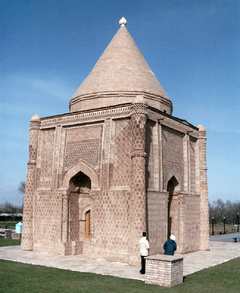 the restored mausoleum of Aisha Bibi | |
| General information | |
| Architectural style | Islamic |
| Town or city | Aisha Bibi |
| Country | Kazakhstan |
The Aisha-Bibi (Kazakh: Айша бибі) is an 11th or 12th-century mausoleum for a noble woman located in the village of Aisha Bibi, 18 km (11 mi) west of Taraz, Kazakhstan on the Silk Road. It is locally famous as a monument to love and faithfulness.
Design
According to legend, the mausoleum was built by a Karakhanid Dynasty ruler for his beautiful fiancée Aisha-Bibi, a daughter of Sufi poet Khakim-Ata. Matching the legend, the mausoleum looks light, well-proportioned, and delicate. The mausoleum's architectural forms and decoration are reminiscent of fine lace. The whole building is covered with carved terracotta tiles using 60 different floral geometric patterns and stylized calligraphy.[1] Aisha Bibi is a direct stylistic descendant of Samanid Mausoleum in Bukhara.[2]
Site
Aisha Bibi is part of a larger complex. Ten meters away is a second mausoleum called Babaji Khatun ("wise queen"), and across the road is a sacred limestone cavern. Together with a garden area and parking lot they form the national monument. The complex is sited on a ridge overlooking the Taraz oasis from the west.
Typology
The entire mausoleum is covered with terracotta panels which help to create the illusion of masslessness typical in Islamic architecture. The terracotta decoration also uses light and shadow rather than color, a pre-Mongol style. Functionally, this type of decoration scatters the light so the viewer is not blinded as he might be from a smooth light colored wall in full sun. The Columns on the corner are shaped after wooden columns used extensively in Soghdian pre-Islamic architecture. There is a band of calligraphy at the point of constriction in each column. In general they describe the beauty of Aisha Bibi and of love in general. One of the old distichs reads: "Autumn... Clouds... The Earth is beautiful".
Materials
Sauran clay was used to make the bricks in both the original and restored Aisha Bibi.[3]
History
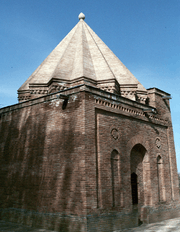
| “ |
There was just an hour to go for 16-year-old beauty Aisha-bibi to meet with her lover. But a tragedy cut the life of the girl… She had estimated herself worthy to marry the Emir of Taraz, and left her home Otrar with her nurse. At the end of their voyage, the two women stopped at the edge of the Talas River to refresh themselves. It is there that bit by a snake, Aysha lost her life. The Emir, informed at the same time of the mission of the young woman and her fine tragedy, came in haste to collect its last sigh and ordered the construction of this tomb. Today nobody can say what color her eyes were. Nobody remembers her voice, habits, and warmth of her hands. But we know the main thing about her: she loved and was beloved. |
” |
| — Kamila Erbol | ||
Current use
The site has been venerated since the Middle Ages. Local women from the Taraz Oasis still pray for children and a happy family. It is customary for newlyweds in Taraz to have their union blessed by the dead lovers. Their ritual reenacts the myth. After the ceremony the wedding party retraces Karakhan's journey from Taraz to the site of his fiancée's death. The journey begins at Karakhan Mausoleum in Taraz and ends at the Aisha Bibi, at each location the bride and groom venerate the dead lovers and ask for their blessing.
Russian archeologist V. V. Bartold was the first scientist to record and study the ruins in 1893.[4] The Soviet Union built a protective glass shell to preserve the monument (c 1960) and used it for the education of students in Taraz and tourism. In 2002, the Republic of Kazakhstan paid Nishan Rameto to restore the Aisha Bibi and built the park infrastructure around it.[3]
Images
- Aisha Bibi Details
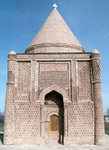 Elevation
Elevation Corner Column
Corner Column Two-Center Arch
Two-Center Arch Detail of Squinch
Detail of Squinch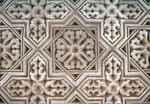 Facade Tile
Facade Tile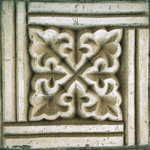 Column Tile
Column Tile Plan 1m=20mm
Plan 1m=20mm
See also
Notes
References
| Wikimedia Commons has media related to Aisha Bibi. |
- "Aisha-Bibi Mausoleum". Oriental Express Central Asia. Archived from the original on 24 June 2006. Retrieved 17 January 2017.
- Kervan, Monique (2002), "Un monument baroque dans les steppes du Kazakhstan : Le tombeau d'Örkina Khatun, princesse Chaghatay?", Arts Asiatiques, 57: 5–32, ISSN 0004-3958
- "History & Ethnography". Samdol Travel Company. Archived from the original on 15 April 2012. Retrieved 17 January 2017.
Further reading
- Knobloch, Edgar (2001). Monuments of Central Asia: A Guide to the Archaeology, Art and Architecture of Turkestan. I.B. Tauris. p. 246. ISBN 1-86064-590-9.
Coordinates: 42°50′01″N 71°12′37″E / 42.83361°N 71.21028°E